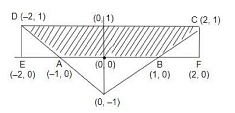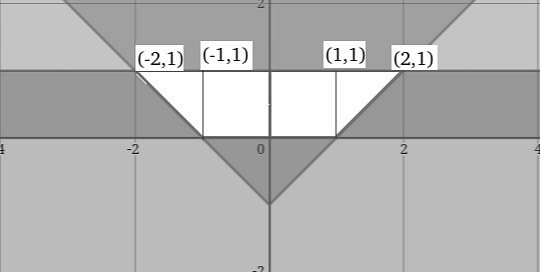The area of the region satisfying the inequalities \(|x|-y≤1,y≥0\) and \(y≤1\) is
Approach Solution - 1
The graph of \(|x|-y≤1,y≥0\) and \(y≤1\) is as follows:
We are given the decomposition: \[ \text{Area of } ABCD = \text{Area of } EFCD - \text{Area of } EAD - \text{Area of } BFC \]
Step-by-step calculation:
Using the formula: \[ \text{Area} = EF \times FC - \frac{1}{2} \times EA \times ED - \frac{1}{2} \times BF \times FC \]
Substitute the values: \[ = 4 \times 1 - \frac{1}{2} \times 1 \times 1 - \frac{1}{2} \times 1 \times 1 \]
Simplifying: \[ = 4 - \frac{1}{2} - \frac{1}{2} = 4 - 1 = \boxed{3} \]
✅ Final Answer: \( \boxed{3} \) square units
Approach Solution -2

We are given the region bounded by the inequalities:
\[ |x| - y \leq 1, \quad y \geq 0, \quad y \leq 1 \]
Step 1: Rewrite the first inequality:
\[ |x| - y \leq 1 \Rightarrow y \geq |x| - 1 \] So the region lies above the curve \( y = |x| - 1 \), and between \( y = 0 \) and \( y = 1 \).
Step 2: Analyze the region:
- The graph of \( y = |x| - 1 \) is a "V"-shaped graph shifted down by 1.
- The region of interest lies between \( y = |x| - 1 \) and \( y = 1 \), for \( y \geq 0 \).
- The intersection points occur where \( |x| - 1 = 0 \Rightarrow |x| = 1 \Rightarrow x = \pm 1 \).
- So the base of the region goes from \( x = -2 \) to \( x = 2 \) at \( y = 1 \).
Step 3: Break the region into geometric shapes:
- A central rectangle of width 2 (from \( x = -1 \) to \( x = 1 \)) and height 1.
- Two right triangles on either side, each of base 1 and height 1.
Total Area:
\[ \text{Area} = \text{Area of rectangle} + 2 \times \text{Area of triangle} \] \[ = (1 \times 2) + 2 \times \left(\frac{1}{2} \times 1 \times 1\right) = 2 + 1 = \boxed{3} \]
Final Answer: \( \boxed{3} \)
Top Questions on Geometry
- ABCD is a rectangle where points C and D have coordinates (−2, 0) and (2, 0), respectively. If the area of the rectangle is 24, what is the best way to describe the equation of the line AB?
- A solid trophy, consisting of two parts, has been designed in the following manner: the bottom part is a frustum of a cone with the bottom radius 30 cm, the top radius 20 cm, and height 40 cm, while the top part is a hemisphere with radius 20 cm. Moreover, the flat surface of the hemisphere is the same as the top surface of the frustum. If the entire trophy is to be gold-plated at the cost of Rs. 40 per square cm, what would the cost for gold-plating be closest to?
- ABCD is a rectangle, where the coordinates of C and D are (-2,0) and (2,0), respectively. If the area of the rectangle is 24, which of the following is a possible equation representing the line AB?
In the given figure, the numbers associated with the rectangle, triangle, and ellipse are 1, 2, and 3, respectively. Which one among the given options is the most appropriate combination of \( P \), \( Q \), and \( R \)?

- A straight line \( L_1 \) has the equation \( y = k(x - 1) \), where \( k \) is some real number. The straight line \( L_1 \) intersects another straight line \( L_2 \) at the point (5, 8). If \( L_2 \) has a slope of 1, which of the following is definitely FALSE?
Questions Asked in CAT exam
- In a $\triangle ABC$, points $D$ and $E$ are on the sides $BC$ and $AC$, respectively. $BE$ and $AD$ intersect at point $T$ such that $AD : AT = 4 : 3$, and $BE : BT = 5 : 4$. Point $F$ lies on $AC$ such that $DF$ is parallel to $BE$. Then, $BD : CD$ is:
- CAT - 2025
- Geometry
- In the sequence 1, 3, 5, 7, ..., k, ..., 57, the sum of the numbers up to k, excluding k, is equal to the sum of the numbers from k up to 57, also excluding k. What is k?
- CAT - 2025
- Arithmetic Progression
- Find the number of integer pairs (x, y) that satisfy the following system of inequalities:
\[ \begin{cases} x \geq y \geq 3 \\ x + y \leq 14 \end{cases} \]
- CAT - 2025
- Linear & Quadratic Equations
- The monthly sales of a product from January to April were 120, 135, 150 and 165 units, respectively. The cost price of the product was Rs. 240 per unit, and a fixed marked price was used for the product in all the four months. Discounts of 20%, 10% and 5% were given on the marked price per unit in January, February and March, respectively, while no discounts were given in April. If the total profit from January to April was Rs. 138825, then the marked price per unit, in rupees, was
- CAT - 2025
- Profit and Loss
- An item with a cost price of Rs.1650 is sold at a certain discount on a fixed marked price to earn a profit of 20% on the cost price. If the discount was doubled, the profit would have been Rs.110. The rate of discount, in percentage, at which the profit percentage would be equal to the rate of discount, is nearest to:
- CAT - 2025
- Profit and Loss